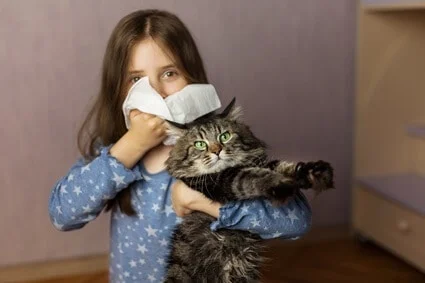You may experience an allergic reaction to some cats, but not others. This does not mean that you are only allergic to certain cats. It just means that you are not noticing the reaction in your body.
The mere presence of a feline does not cause cat allergies. The cat’s dander is to blame. Dander contains a glycoprotein called fel d 1, which is what sparks an allergic reaction. Some cats have more fel d 1 than others, which explains why they may lead to stronger reactions. Unneutered males present the greatest risk.
Cat allergies do not mean that you must avoid all cats. Equally, you will not necessarily be able to assess whether you’ll experience a reaction based solely on the cat’s breed. Just take steps to protect yourself around all felines.
Am I Allergic to Cats?
According to Allergy, Asthma, and Immunology Research, about 10% of people are allergic to domesticated animals. Cat allergies are twice as common as sensitivity to dogs. Symptoms of an allergy to cats include:
- Uncontrollable sneezing, coughing, and wheezing
- Itchiness around the eyes
- Runny nose and stuffiness
- Hives and rashes around the face and chest
- Redness and inflammation on the skin that touched the cat
If you exhibit these symptoms when approached by a cat, an allergy is the most likely explanation. Some cats will spark an immediate reaction, while others will appear to have no reaction whatsoever. In rare cases, you may even experience a delayed response.
If you have a feline allergy, you are allergic to all cats. Unique characteristics found in the specific cat dictate how severe the allergic reaction will be. You may be experiencing a reaction, but it’s minor enough not to notice. Your body may also be building a resistance to the allergy.
What Causes Cat Allergies?
It is a common misconception that any exposure to cat fur will trigger an allergic reaction. The fur itself is not the problem. Rather, the problem is caused by the dander that the cat releases when it sheds.
Cats’ dander is made up of dead skin cells, dry urine, and saliva. All cats seasonally shed their fur, which releases dander into the atmosphere. If you have a cat allergy, your body will react to this dander.
Why Does Cat Dander Cause Allergies?
Cat dander contains a glycoprotein called fel d 1. It is fel d 1 that provokes a cat allergy. Fel d 1 is measured in nanograms (ng). According to The American Review of Respiratory Disease, a cat’s presence in a room increased the fel d 1 level by up to 90ng/m. This is sufficient to provoke an allergic reaction in somebody with a feline allergy.
Fel d 1 can become trapped in the air in an enclosed space. This means that reactions still occur after a cat leaves the territory. The protein also lives in carpet fibers and soft furnishings. This is why entering a cat’s home can cause allergies, regardless of whether the cat is present or not.
Why Am I Only Allergic to Some Cats?
An allergy to one cat means that you have an allergy to all cats. In theory, less fur and shedding means a reduced likelihood of noticeable allergic reactions, but this is not actually the case.
Longhaired cats actually release less dander, not more. This is because longhaired cats hold proteins against their skin more effectively. A Maine Coon, for example, will shed more fur than a Chartreux. This does not necessarily make it likelier to provoke allergies.
Also, female cats usually release less Fel d 1 than males. Unfixed males, in particular, release sizable amounts of dander. The presence of testosterone increases the potency of glandular secretions.
Some scientists believe that cats with lighter fur release less fel d 1 than darker cats. This suggests that a female Persian with white fur is less likely to provoke allergies. A black, male American Shorthair, meanwhile, could be more of an issue. However, these findings are disputed by different experts.

Are There Hypoallergenic Cat Breeds?
Some cat breeds are considered hypoallergenic, meaning that they should not provoke allergies. Unfortunately, there is no science to bear out this theory. All cats will cause an allergic reaction to some extent. The best an allergy sufferer can hope for is a mild response that goes unnoticed.
The following cat breeds are considered hypoallergenic and should not provoke extreme allergic reactions:
- Devon or Cornish Rex
- Balinese
- Javanese
- Bengal
- Oriental or Colorpoint Shorthair
- Russian Blue
- Siberian
The closest thing to a truly hypoallergenic cat is the Sphinx breed. As these cats are hairless, they have no fur to shed. These cats still shed dead skin cells, though. Traces of urine from the litter tray and saliva from grooming will also remain problematic as Fel d 1 is also found in these sources.
There is also the possibility of being licked or scratched by the cat. These actions will spark an allergic reaction without fail. The cat directly applies saliva to your skin, leading to redness, swelling, and other symptoms.
Can I Become Immune to My Cat Allergy?
You may feel that you are not allergic to your own cat, but others. You may find a similar experience with other cats that you spend more time with. Those of neighbors or family members, for example.
In these cases, your body has likely built a degree of resistance to the cat’s dander. The Journal of Allergy and Clinical Immunology explains how Fel d 1 is used as a treatment for cat allergies.
The glycoprotein is injected in small doses, steadily building immunity. After around a year of this therapy, immunity will be vastly improved. The allergy will still exist, but it will not cause such a reaction.
The American Journal of Respiratory and Critical Care Medicine explains how exposure therapy is especially effective for children. Fewer young people exposed to cats developed asthma, even with a family history.
Can I Get a Shot for Cat Allergies?
Immunotherapy shots can offer relief from cat allergies. Also, a Swiss pharmaceutical company named HypoPet AG is working on an allergy vaccine, dubbed HypoCat.
As explained by the Journal of Allergy and Clinical Immunology, this shot is actually for cats. It will require 3 doses over 9 weeks. A booster will follow 6 months later. No side effects for the cat are anticipated. The shot will fill a cat’s body with antibodies that neutralize the effect of fel d 1. This will make dander completely harmless.
How To Reduce Cat Allergies
If you are a cat lover, allergies can be really frustrating and upsetting. This irritation will be magnified if you are only allergic to certain cats that you really like. The good news is that this suggests that your allergy is not as serious. An allergy does not mean you can never approach cats again. You will not need to rehome a family cat either.
While you are waiting for HypoCat, you can minimize the effects of cat allergies. Use this approach with every feline you encounter, as you won’t know how you will react to a cat until the allergic reaction takes hold.
Prepare to Be Approached
A curious quirk of feline behavior dictates that cats will often approach somebody with an allergy. As explained by Animal Behavior and Welfare, cats understand human facial expressions. This means a cat will recognize the smile of a cat lover. Experience teaches the cat that petting and handling will quickly follow.
Some cats will welcome this, but most will proceed with caution. Until a bond of trust has been forged, the cat will be wary of human contact. The cat wants to remain in control and transfer its scent to a new human.
This is why cats are attracted to those with allergies. Such a person is unlikely to touch the cat. If anything, it will keep its distance. In the cat’s mind, this makes the person safe to approach. The cat will rub itself on the person’s legs, claiming this non-intrusive human as its own.
Protect yourself from these advances by positioning yourself in a shielded position, explaining the situation to others. Ask somebody to reposition the cat quickly, and it will start to lose interest in you.
Handle with Care
If you must handle a cat, avoid any on-skin contact. Wear long sleeves and even gloves if necessary. While handling the cat, be delicate. Don’t be tempted to shoo the cat or use a loud voice to frighten it off.
A scared cat may bite or swipe with its claws. As fel d 1 lives in saliva, this is especially dangerous. A bite could cause harm to somebody with a cat allergy. Clawing is not much safer as you run the risk of a nasty infection or worse.
While handling a cat, hold it away from your face, and try not to breathe too deeply. Above all, stay calm. If the cat senses that you are distressed, it may panic. The cat will assume that it is in danger, leading to bites and scratches.

Purify the Air
Fel d 1 usually lives in the air, so you must keep air flowing if you have a cat allergy. Once feline dander enters the air, it takes just one deep breath to cause an allergic reaction.
If you have an allergy and live with a cat, you should get an air purifier. This will keep fresh air circulating around your home. If this is not an option, keep some windows open. Ensure that you’re not left enclosed with feline dander.
Keep the Home Clean
Fel d 1 does not just live in the air. If you have a cat allergy, ensure that your home is regularly dusted. Unfortunately, doing cleaning the property yourself may result in sneezing or other allergy symptoms. Consider hiring a part-time cleaner or using an electronic device to suck up any dust.
Don’t focus too much on the cat itself, as bathing a cat rarely reduces dander and shedding. However, if you brush your cat’s fur, you can control shedding. This, in turn, minimizes dander in the air and on the floor.


Thank you Richard, I found the information you supplied very helpful. One question, can cats be allergic to peoples dander, or even there own dander. I have an adopted kitty, that coughs & noticed it is mostly after it has bathed itself, which is often, but no hair balls. Look forward to your comments.
It’s rare for cats to be allergic to human dander. More commonly, cats might be allergic to environmental allergens like dust, pollen, or even certain proteins in their own saliva—which could potentially cause reactions when they groom themselves. The coughing you’re noticing, especially after your kitty has bathed, might be due to an irritant or an underlying condition such as feline asthma rather than an allergy to dander per se.
Since each cat is unique, I’d recommend having your vet take a closer look. They can help determine if it’s an allergy or perhaps another respiratory issue, and suggest the best course of action for your adopted kitty.
This explains a lot about why my friend does just fine with my cat. We thought she had a helpful genetic mutation.
She is a long-haired female cat that is brushed regularly. In addition, I change our HEPA HVAC filters often, and have air filters running in various parts of our house.
Since experience the joy of MY cat (and the joy of being able to breathe) he desperately wants his own cats. Your article has helped us figure out what type of kitties to seek out!
This saves us a lot of research.